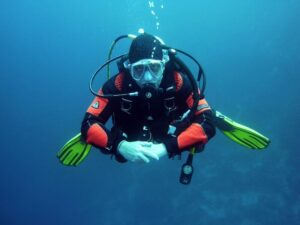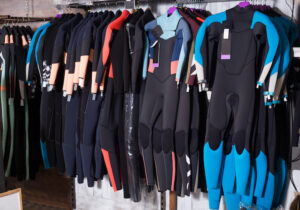Boogie boarding is affordable, it is easy to learn, and it is a lot of fun! However, just as no boogie boarder is like another, the boards also come in all sizes, shapes, and materials. Nothing ruins the fun of learning a new sport more than getting frustrated over the material. Picking the perfect match for your body type and skill level might seem like a science for itself. But if you follow a handful of easy key points, you will be ready to go and choose a board yourself like a professional in no time.
In this article, you will get answers to the following questions:
- What different kinds of boogie boards are there?
- How to pick the right boogie board size?
- Which boogie board is best for beginners?
- And which type of boogie board is recommended for advanced riders?
What size boogie board do I need?
Any foam board will do? Oh no, not at all! Not only do size, material, and shape determine whether the board can carry you, but in the same way, whether you can carry the board comfortably. “Bigger is better!” does not apply in that case. Just as the common mistake that choosing the professional-grade material will automatically make the rider a professional.
But before we delve deeper into what to get and what mistakes to avoid, let’s clarify a few points. While you might catch a nice little ride on a wave using any kind of foam block or floating device you have at hand, choosing a proper bodyboard that aligns with your body measurement will enhance the fun immensely.
For over 50 years, sports enthusiasts and creative minds have been optimizing the original boogie board, adding a few extras, and pushing the limits of what is possible further and further.
Want to know how to use a boogie board? Read this boogie board guide!
The right board core
The main purpose of the board is to keep your body afloat. To ensure this, the very first body board, invented in 1971 by the charismatic inventor Thomas Morey, was made of Polyethylene, commonly known as PE foam.
The three most common materials used nowadays are Polypropylene foam (PP), extruded Polystyrene (XPS), and Polyethylene foam (PE). Even though chemically the differences between these materials are barely noticeable, they vary significantly when it comes to temperature response and load-bearing capacity.
Polyethylene foam
PE was not only the original material choice, but is also the most used core material to the present day. It provides a wide range of motion to the rider, as it makes the board comparatively flexible. Whatever movement the surfer makes, the board will respond instantly. Because of that, it is not recommended to use it in warmer water. It can become even less stable, making it challenging for beginners to maintain their balance.
Polypropylene foam
Boards with a PP core are lighter, allowing them to sit higher in the water and move faster. They are also stiffer, which can result in slower steering reaction. However, when executed correctly, they offer precise control. This makes them ideal for professional surfers, attempting technically challenging maneuvers on bigger waves.
Extruded Polystyrene
XPS is the lightest and most water-repellent core material. It can break easier than the other two material options, making it unsuitable for rougher conditions but a superb beginners board core.
Another innovation to enhance board stability is the use of stringers. These thin, mostly hollow tubes are placed in the middle of the board, running through it like a spine. They ensure the board stability for heavier surfers, absorb harder landings and can compensate for a change of the water temperature. The extremer the conditions, the more stringers can be added.
Choosing the board length
Choosing the right board length is indeed the most important criteria when buying a boogie board. The usual sizes range from 30 inches for children, to 46 inches for very tall surfers. To determine which length is the perfect match, there are two main methods.
Method 1:
Put the board upright next to your body. Position the tail’s tip next to your feet. If you picked the right board, the nose will reach the area surrounding your belly button. This method is the fastest and quickest, but also the least precise.
Method 2:
A slightly more exact approach is the measurement of the chin-knee distance. When standing upright, your bodyboard should approximately reach from the tip of your chin to your patella.
These methods ensure a comfortable hip position and elbow placement. Yet both methods overlook one essential factor – the weight of the rider. Heavier surfers require more buoyancy in the board to stay afloat on the water surface, instead of simply sinking.
As a general thumb rule, heavier surfers want to add 1 to 2 inches to the initially determined length, while lighter surfers can reduce the result about 1 to 2 inches.
The shorter the board is, the more the legs will be hanging in the water, causing the board to slow down and potentially creating unwanted turbulences. With a bigger board, especially as a beginner, you will always be on the safer side.
It makes the first steps easier and guarantees a fast ride, regardless of the size and power of the waves. The only downside is that advanced turns and tricks become more challenging with a bigger board.
Width, Thickness, and Tails
In the last years, board designs have leaned more and more towards thinner boards. While the normal board thickness used to be around 55 millimeters, it nowadays lies at around 51 millimeters. Thanks to the improvements in the material department, this not only saves material in the production, but increases the flexibility and the board’s responsiveness at the same time.
When considering the width of a board, one might initially think about choosing a board that is easiest to carry. Therefore, it would be enough to simply get a board that sits comfortably when you clamp it underneath your arm. Yet, the width has quite an impact on the speed and maneuverability of the board. Slimmer boards allow faster and sharper movements, giving room for crazier stunts.
The same goes for the tail. Boogie boards do not have fins, what makes the tail carry the balance and maneuverability all by itself. A wider tail keeps the board afloat easier but makes turns and technical maneuvers more complicated.
The board type
When entering a Surf shop, the mass of boards presented will probably look all the same on the first gaze, but on closer observation, more details will come to attention. Not only the dimensions of the board, but the different shaped tails, deserve a closer look as well.
There is no such thing as the best or worst board type. It all comes down to your surf style and needs. The two main types of boogie board tails are the Crescent tail and the Bat tail. Since the tail is the last exit point for the water underneath the board, it has an essential influence on the riding experience and surf possibilities.
The Crescent tail
The Crescent tail is the most common type. The first body board had a simple straight cut at the end, and over time, the middle part was gradually cut out further to adapt to the body, pressing against it. The Crescent style resembles the shape of a soft bow, leading to two hydrodynamic tips on the left and right.
The Bat tail
The Bat tail is shaped like the wings of a bat, with two pointy tips at the edges. Unlike the Crescent tail, the Bat shape doesn’t lead to one jointed indent, but forms two sharper and smaller indents, that converge in the middle of the tail, forming a third tip.
This shape increases the board’s contact with the water and is more common amongst professional riders.
Boogie board size chart
With the help of a Size-Weight-Chart, finding the perfect board length can be done even more precisely. Simply find the right row and column, aiming at your weight and height, and the perfect board size is basically guaranteed.
| Weight | Height | Bodyboard Length |
| < 65 lbs. | < 4′ | 32″-35″ |
| 65-85 lbs. | 4′- 5′ | 36″-38″ |
| 85-115 lbs. | 4’6″- 5’2″ | 39″ |
| 115-130 lbs. | 5’3″- 5’6″ | 40″ |
| 125-170 lbs. | 5’7″- 5’9″ | 41″-42″ |
| 145-180 lbs. | 5’9″- 6’0″ | 42″ |
| 160-190 lbs. | 5’10”- 6’2″ | 42″-43″ |
| 170-210 lbs. | 6’1″- 6″3′ | 43″ |
| 180-270 lbs. | 6’2″- 6″4′ | 44″ |
| 195-255 lbs. | 6’3″- 6″6′ | 45″ |
| 200+ lbs. | 6″4’+ | 46″ |
Want to know which bodyboard size or surfboard size you need? Learn more here
What you should know about the boogie board size
The real question is, what you should not know about choosing the right size. And the simple answer is: Nothing! It’s important to be well-informed and avoid relying on possible misinformation or simply picking the cheapest board available. Riding an ill-fitting board will only take away the fun boogie boarding can bring.
No. 1: Invest those 5 minutes
Don’t rush the process. Figure out the right size, and not necessarily in the fastest method. Take your time, measure your height and weight, take a look in the table and enjoy your perfectly fit board! It will be worth every second of preparation time.
No. 2: Trust the process
Nobody was born to be real Aquaman – we all must start somewhere. Carrying the board doesn’t have to feel natural. Take the board into the waves with you, give it a try, and if it doesn’t work on the first wave, try again. Sooner or later, the first stumbling attempts will be a fading memory.
No. 3: Do your own research
Whether about the surf area or buying a board. Gather as much information as possible to be able to make an educated decision. Not all store owners are body surfers themselves, so come prepared, know what you want, and remain open for advices people may offer.
Conclusion: Boogie board size for adults
You feel like finding the right size just became a gigantic project, overwhelmed by all the information? Let’s focus on the most important facts. Finding the right size is the first step of a great boogie boarding experience. Especially as a beginner, it is best to try a wider and thicker board first.
This will give you the comfort needed to focus on positioning your body and riding waves, even if they are smaller and less powerful. Gradually you will learn how to trust the board until you feel ready to try out more advanced stunts.
The further the learning process, the bigger the waves, and the more difficult your tricks become, the more you can transition to a slimmer and lighter board. This will give you better control over your moves, rather than being controlled by the force of the waves.
FAQ – Most asked questions about boogie board size
When choosing between a Bat tail and a Crescent tail, especially for beginners, the two won’t feel very different. However, the Crescent shape is considered the safer choice. It provides more balance on the wave and guarantees a comfortable hip position.
The smaller and lighter you are, the smaller the board should be. To learn how to select the perfect board length, check the body-size chart in the previous chapters.
Especially for beginners, the focus lies more on catching the first waves and finding the right position on the board. Therefore, slightly bigger and thicker boards offer the buoyancy and stability needed. The core of beginner boards is mostly made of extruded polystyrene, which has the nice side effect of providing cushioning for your elbows.
The more experienced and the more advanced your tricks become, the thinner and lighter the board can be. The less material, the sharper the response of the board. Usually, PE and PP cores will offer more flexibility and can be enhanced with stringers to adapt to the surfer’s personal preferences. However, if you want to switch things up and try out the dropknee position or even try to stand up, you will need to grab a longer board.









